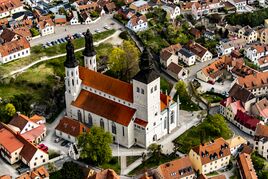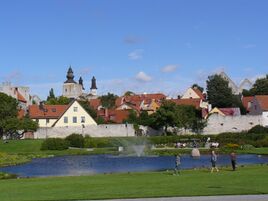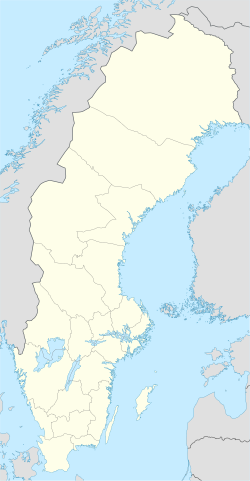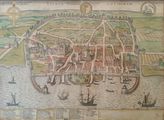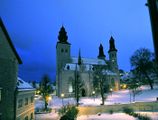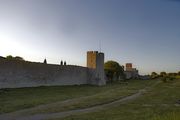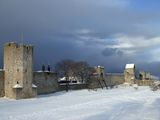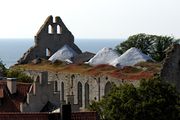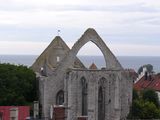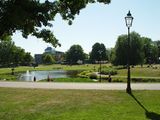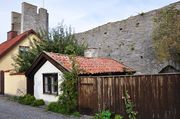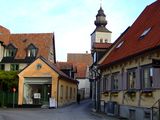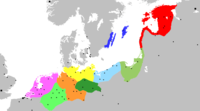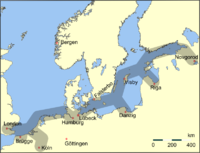ڤيسبي
Visby
Böi or Böin (Gutnish) | |
|---|---|
Clockwise from top: the Visby Cathedral; ruins of the Saint Nicolai Church; Almedalen | |
| الكنية: مدينة الورود | |
| الإحداثيات: 57°38′05″N 18°17′57″E / 57.63472°N 18.29917°E | |
| البلد | السويد |
| المقاطعة | گوتلاند |
| County | مقاطعة گوتلاند |
| البلدية | بلدية گوتلاند |
| Charter | 1645 |
| المساحة | |
| • Locality | 12٫44 كم² (4٫80 ميل²) |
| التعداد (31 ديسمبر 2012)[2] | |
| • Locality | 23٬576 |
| • الكثافة | 1٬816/km2 (4٬700/sq mi) |
| • العمرانية | 57٬241 |
| منطقة التوقيت | UTC+1 (CET) |
| • الصيف (التوقيت الصيفي) | UTC+2 (CEST) |
| Postal code | 621 xx |
| مفتاح الهاتف | (+46) 498 |
| الموقع الإلكتروني | www |
| موقع تراث عالمي لليونسكو | |
| Official name | Hanseatic Town of Visby |
| السمات | Cultural: iv, v |
| مراجع | 731 |
| التدوين | 1995 (19 Session) |
ڤيسبي Visby [ˈviːsbʏ] هي تجمع حضري ومقر بلدية گوتلاند في مقاطعة گوتلاند، السويد بتعداد 23,576 نسمة، في 2012.[2] ڤيسبي هي أيضاً مقر القاصد الرسولي لـ أبرشية ڤيسبي. وهي التجمع الوحيد ذو وضع مدينة تاريخياً على جزيرة گوتلاند. المدينة الهانزية ڤيسبي يمكن المجادلة بأنها أفضل مدينة من العصور الوسطى محتفظة بشكلها الأصلي في اسكندناڤيا ومنذ 1995، فإنها حسب اليونسكو موقع تراث عالمي.[3] وبين أهم الآثار التاريخية فيها بطول 3.4 كيلومتر نجد سور المدينة الذي يحيط بوسط البلدة وعدد من أطلال الكنائس.
وتعد ڤيسبي مقصد عطلات شهير لسكان اسكندناڤيا في الصيف وتستقبل آلاف السياح سنوياً. It is by far the most populated locality outside the Swedish mainland. Visby is also the only municipality seat of Sweden that is accessible only by boat and air traffic. The University of Gotland is in Visby, and since 1 July 2013, it is a department of Uppsala University under the name Uppsala university–Campus Gotland.
أصل الاسم
The name "Visby" comes from the Old Norse Vis, (genitive singular of Vi) meaning "(pagan) place of sacrifices", and by, meaning "village". In the Gutasagan (mid 14th century) the place is referred to as just Wi meaning "holy place, place of worship".[4]
Visby is sometimes called "The City of Roses" or "The City of Ruins".[5][6][7]
التاريخ
![]() اتحاد كالمار 1397–?
اتحاد كالمار 1397–?
![]() السويد 1645–?
السويد 1645–?
![]() Russian Empire 1808[أ]
Russian Empire 1808[أ]
![]() السويد 1808–1814
السويد 1808–1814
![]() Sweden–Norway 1814–1905
Sweden–Norway 1814–1905
The earliest history of Visby is uncertain, but it is known to have been a centre of merchandise around 900 AD. It was inhabited as early as the Stone Age, probably because of the access to fresh water and a natural harbour.[8] The oldest finds at the site of present-day Visby are what have been interpreted as "beach huts", with the radiocarbon dating method to the 7th–9th centuries AD.[9]
In the 12th century, Visby Cathedral, dedicated to Saint Mary, was constructed. It was reshaped in the 13th century to its current appearance, and was officially opened in 1225,[10] by the bishop of the Swedish city of Linköping (in regional map). Several other churches were also constructed in the ensuing centuries. The city flourished, thanks to the German Hanseatic League.[11]
The work on the ring wall was likely begun in the 12th century. Around 1300, it was rebuilt to reach its current height, acquiring the characteristic towers, although some towers were not constructed until the 15th century. The ringwall is still largely intact.[12]
In the first half of the 14th century (1300–1350), Visby was at the height of its wealth and influence, and it was during this time that Laws of Wisbuy, a set of maritime laws that had broad influence in the Baltic and beyond, were probably promulgated.[13]
In 1361, Gotland was conquered by Valdemar IV of Denmark. 1,800 Gotlanders were killed in battle in front of the city. Valdemar tore down part of the wall, set up three huge beer barrels and threatened to turn his men loose to pillage the town unless they were filled with silver and gold. The Visby city fathers fulfilled the demand, with churches stripped of their valuables. Valdemar added "King of Gotland" to his title list.[14] His treatment of Visby, a member of the Hanseatic League, precipitated that League into war with Denmark; however, though Valdemar was forced into various concessions, he retained Visby as a Danish city.[15]
In 1391, 1394 and 1398, it was taken and plundered by the Victual Brothers, pirates who sailed the Baltic Sea. An invading army of Teutonic Knights conquered Gotland in 1398, destroyed Visby and expelled the Victual Brothers.[15] In 1409, Grand Master Ulrich von Jungingen of the Teutonic Knights guaranteed peace with the Kalmar Union of Scandinavia by selling the island of Gotland to Queen Margaret of Denmark, Norway and Sweden.[15]
In 1411, the Norwegian, Danish and Swedish King Eric of Pomerania had the castle of Visborg constructed, and settled himself there for 12 years, during which the city virtually became a pirates' nest, and the commerce halted. As of 1470, the Hanseatic League rescinded Visby's status as a Hanseatic town.[15]
In 1525, the final blow came. In the Danish throne quarrel, Lübeck, a Free City of the Holy Roman Empire and a leading member of the Hanseatic League, supported Frederick I, while Søren Norby the Danish governor of Gotland fought for Christian II, even after Christian's official resignation in 1523. While Norby fought a military action in Sweden, the Lübeckers successfully attacked Visby and set the city on fire from four sites. But unlike widespread belief, several churches survived at first. The churches of St. James (which already had been closed before), St. Nicholas and St. Gertrude were sacked by Lübeck's army. With the reformation, all churches except St. John, which became the city parish, were closed. In 1528, the citizens of Visby sacked the church of the Holy Trinity, or the church of Our Lord (سويدية: Drottens kyrka) in revenge for the plundering of their town. In 1533–34, the new Danish governor, Henrik Nielsen Rosenkrantz, demolished St. John's and St. Peter's churches to improve the defence of his castle Visborgs slott. St. Mary's Cathedral remained the last functional church and became the new city parish.[15][16][17]
Gotland was again taken into Sweden's possession in 1645, by the Treaty of Brömsebro, after 300 years of Danish rule.[15] The city developed slowly as things were left as they were.[18] In the mid 18th century, after a plague had reduced Visby's population, some attempts were made by Swedish government officials to improve living standards, but little was accomplished. Not until the early 19th century did Visby once again attract commerce and a harbour industry. At the same time – 1808 – Gotland was conquered by Russia, but was peacefully taken back by the Swedes after only a couple of months.[15]
الجغرافيا
Visby is the name of the locality, or town, as well as the name of the larger area surrounding it, Visby socken. In 1936, the socken was incorporated within the newly formed Visby stad (Visby city), the only locality with historical city status on Gotland. Visby socken comprises the same area as the administrative Visby District, established on 1 January 2016.[19][20] اعتبارا من 2019[تحديث], Visby Cathedral, Visborg Church and Terra Nova Church in Visby belong to Visby Cathedral parish (Visby Domkyrkoförsamling).[21][22] Visby is also the only municipality seat of Sweden that is accessible from the mainland only by boat and air traffic.
Visby is situated on the central west coast of Gotland, on the rather steep slopes of limestone cliffs surrounding the first natural harbor. The town has evolved around the medieval harbor that now constitutes the Almedalen park. Long streets run parallel with the old shoreline with shorter alleys at a straight angle from these, lead from the harbor and up the slope up to the eastern higher part of town known as Klinten.[23]
The old, original part of Visby is more or less enclosed by the city wall to the north, east and south, with the old harbor and the Baltic Sea in the west. The more modern parts of the town expand mostly east and inland from the wall. Along the shore south of the wall is the modern harbor with its ferry terminals and further south is a green recreational area called Södra Hällarna. Just inside the north part of the wall as well as along the north coast outside the wall, are several beaches: Kallbadhuset, Norderstrand, Snäckgärdsbaden (or simply Snäck) and Gustavsvik.[24]
Visby and Tallinn are the only two North-European towns in which the city's medieval grid plan has been fully preserved into present day.[بحاجة لمصدر]
One of the asteroids in the asteroid belt, 6102 Visby, is named after this place.[25]
المناخ
According to the Köppen climate classification, Visby has an oceanic climate. This renders cooler summers and milder winters than most of mainland Sweden. The precipation is very dry for an oceanic climate, but is relatively consistent throughout the year.[بحاجة لمصدر]
| بيانات المناخ لـ ڤيسبي، 1961–1990 | |||||||||||||
|---|---|---|---|---|---|---|---|---|---|---|---|---|---|
| الشهر | ينا | فب | مار | أبر | ماي | يون | يول | أغس | سبت | أكت | نوف | ديس | السنة |
| القصوى القياسية °س (°ف) | 10.2 (50.4) |
12.2 (54.0) |
18.6 (65.5) |
25.2 (77.4) |
27.7 (81.9) |
31.4 (88.5) |
33.7 (92.7) |
31.8 (89.2) |
29.0 (84.2) |
20.0 (68.0) |
13.5 (56.3) |
11.4 (52.5) |
33.7 (92.7) |
| متوسط القصوى اليومية °س (°ف) | 1.1 (34.0) |
0.7 (33.3) |
3.3 (37.9) |
7.6 (45.7) |
13.9 (57.0) |
18.2 (64.8) |
20.1 (68.2) |
19.4 (66.9) |
15.3 (59.5) |
10.8 (51.4) |
6.0 (42.8) |
2.9 (37.2) |
9.9 (49.9) |
| المتوسط اليومي °س (°ف) | −0.5 (31.1) |
−1.2 (29.8) |
0.7 (33.3) |
4.1 (39.4) |
9.5 (49.1) |
14.0 (57.2) |
16.4 (61.5) |
16.0 (60.8) |
12.4 (54.3) |
8.5 (47.3) |
4.3 (39.7) |
1.2 (34.2) |
7.1 (44.8) |
| متوسط الدنيا اليومية °س (°ف) | −2.4 (27.7) |
−3.1 (26.4) |
−1.7 (28.9) |
1.4 (34.5) |
5.9 (42.6) |
10.7 (51.3) |
13.4 (56.1) |
13.2 (55.8) |
10.0 (50.0) |
6.4 (43.5) |
2.5 (36.5) |
−0.6 (30.9) |
4.6 (40.4) |
| الصغرى القياسية °س (°ف) | −25.0 (−13.0) |
−25.4 (−13.7) |
−23.5 (−10.3) |
−12.7 (9.1) |
−6.9 (19.6) |
−1.0 (30.2) |
2.9 (37.2) |
1.1 (34.0) |
−2.9 (26.8) |
−6.0 (21.2) |
−11.5 (11.3) |
−22.2 (−8.0) |
−25.4 (−13.7) |
| متوسط تساقط الأمطار mm (inches) | 53 (2.1) |
29 (1.1) |
35 (1.4) |
29 (1.1) |
29 (1.1) |
30 (1.2) |
50 (2.0) |
49 (1.9) |
58 (2.3) |
48 (1.9) |
58 (2.3) |
54 (2.1) |
522 (20.5) |
| Source: Hong Kong Observatory.[26] | |||||||||||||
معرض الصور
التاريخ
Visby circa 1700, in Suecia Antiqua et Hodierna
مشاهد عامة
Visby Cathedral, view from the east
مناظر عامة
ميناء ڤيسبي
انظر أيضاً
- أسوار مدينة ڤيسبي
- Diocese of Visby
- معركة ڤيسبي
- مطار ڤيسبي
- Campus Gotland
- Almedalen Week
- List of governors of Gotland County
- List of churches on Gotland
- List of church ruins on Gotland
الهامش
- ^ "Tätorternas landareal, folkmängd och invånare per km2 2005 och 2010" (in Swedish). Statistics Sweden. 14 December 2011. Archived from the original on 10 January 2012. Retrieved 10 January 2012.
{{cite web}}: Unknown parameter|deadurl=ignored (|url-status=suggested) (help)CS1 maint: unrecognized language (link) - ^ أ ب "Gotland i siffror, pdf". www.gotland.se. Region Gotland. Retrieved 17 June 2014.
- ^ "21 World Heritage Sites you have probably never heard of". Daily Telegraph.
- ^ Nationalencyklopedin, article "Visby"
- ^ "Visby innerstad". www.gotland.net. Visit Gotland. Retrieved 15 June 2014.
- ^ "Smeknamn och öknamn på svenska städer". www.cercurius.se. Cercurius AB. Archived from the original on 14 May 2017. Retrieved 15 June 2014.
- ^ Blom, Ewdward (2 July 2013). "Rosornas stads mest urvattnade tradition". Expressen (in السويدية). Retrieved 15 June 2014.
- ^ Westholm, Gun (2000). "Visby och Gotland – Medeltida byggnadsutveckling". Gotländskt Arkiv. Visby: Gotlands fornsal. 2000 (72): 85.
- ^ Westholm, Gun (2000). "Visby och Gotland - medeltida byggnadsutveckling". Gotländskt arkiv: 2000 (72), s. 85–104 : ill.
- ^ Björkander 1898, p. 88.
- ^ Yrwing, Hugo (1986). Visby – hansestad på Gotland (in السويدية). Stockholm: Gidlund. ISBN 91-7844-055-6. Retrieved 12 June 2014.
- ^ Andrén, Anders (2011). Det medeltida Gotland: en arkeologisk guidebok. Lund: Historiska media. ISBN 978-91-85873-83-8. Retrieved 15 June 2014.
- ^ Stone, Arthur J. (October 1842). "Canada's Admiralty Court in the Twentieth Century" (PDF). McGill Law Journal. 47: 511–558. Archived from the original (PDF) on 20 October 2017. Retrieved 11 April 2016.
- ^ Westholm, Gun (2007). Visby 1361: Invasionen (in السويدية). Stockholm: Prisma. ISBN 978-91-518-4568-5. Retrieved 12 June 2014.
- ^ أ ب ت ث ج ح خ Martinsson, Örjan. "Gotland". www.tacitus.nu. TACITUS.NU. Retrieved 12 June 2014.
- ^ "Slottsguiden, S:ta Karin, Sverige".
- ^ "Slottsguiden, S:t Per och S:t Hans, Sverige".
- ^ Englund, Peter (2003). Ofredsår (in السويدية). Stockholm: Atlantis. pp. 368 and 394. ISBN 91-7486-349-5.
- ^ "Förordning om district" [Regulation of districts] (PDF). Ministry of Finance. 17 June 2015. Archived (PDF) from the original on 2015-12-31. Retrieved 24 May 2016.
- ^ The exact extent of the old socken, now district, can be obtained by clicking on Kartinställningar and check the Socken box in the menu of this map from the Swedish National Heritage Board database.
- ^ "Församlingar på Gotland". www.svenskakyrkan.se. Church of Sweden. Retrieved 13 January 2019.
- ^ "Visby stifts indelning 2018". www.svenskakyrkan.se. Church of Sweden. Retrieved 13 January 2019.
- ^ "Visby". www.ne.se. Nationalencyklopedin. Retrieved 24 June 2016.
- ^ "Välkomna till Visby!" [Welcome to Visby!]. www.gotland.net. Gotlands Media AB. 23 April 2014. Retrieved 24 June 2016.
- ^ "6102 Visby (1993 FQ25)". NASA. Retrieved 24 June 2016.
- ^ Climatological Information for Visby, Sweden, Hong Kong Observatory accessed 1 May 2012.
وصلات خارجية
- Gotland Tourist Association – Visby
- The official Medieval Week Visby site
- Visby - a world heritage town
 "[[s:Collier's New Encyclopedia (1921)/{{{1}}}|{{{1}}}]]". Collier's New Encyclopedia. 1921.
"[[s:Collier's New Encyclopedia (1921)/{{{1}}}|{{{1}}}]]". Collier's New Encyclopedia. 1921.
قالب:World Heritage Sites in Sweden
خطأ استشهاد: وسوم <ref> موجودة لمجموعة اسمها "lower-alpha"، ولكن لم يتم العثور على وسم <references group="lower-alpha"/>
- Pages using gadget WikiMiniAtlas
- CS1 errors: unsupported parameter
- CS1 السويدية-language sources (sv)
- Short description is different from Wikidata
- Pages using multiple image with auto scaled images
- Coordinates on Wikidata
- Pages with plain IPA
- Articles containing سويدية-language text
- Pages using Lang-xx templates
- مقالات فيها عبارات متقادمة منذ 2019
- جميع المقالات التي فيها عبارات متقادمة
- Articles with unsourced statements from December 2016
- Articles with unsourced statements from November 2014
- ڤيسبي
- أعضاء الرابطة الهانزية
- Municipal seats of Gotland County
- أماكن مأهولة في مقاطعة گوتلاند
- موانئ بحر البلطيق
- Romanesque architecture in Sweden
- Swedish municipal seats
- مواقع التراث العالمي في السويد
- أماكن مأهولة في عصر الڤايكنگ
